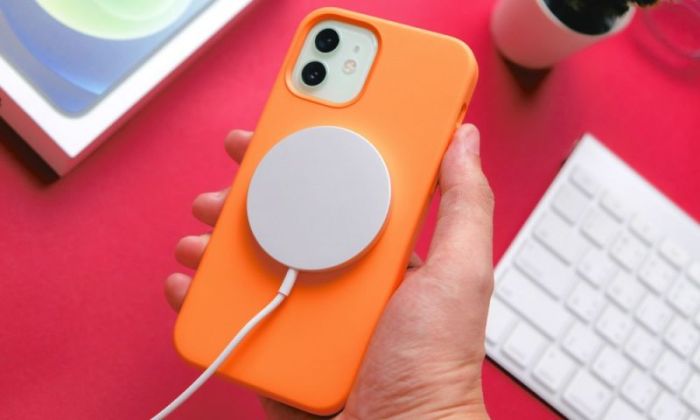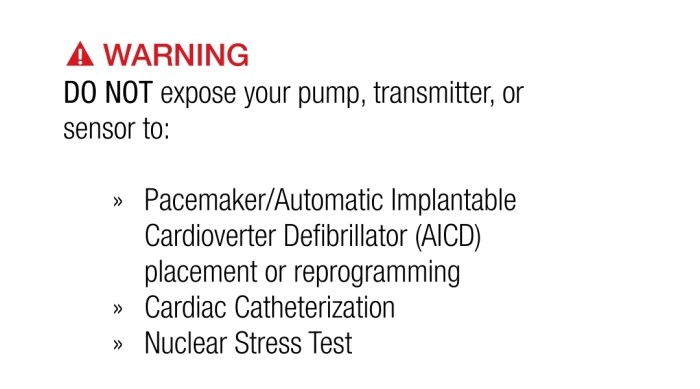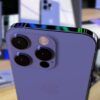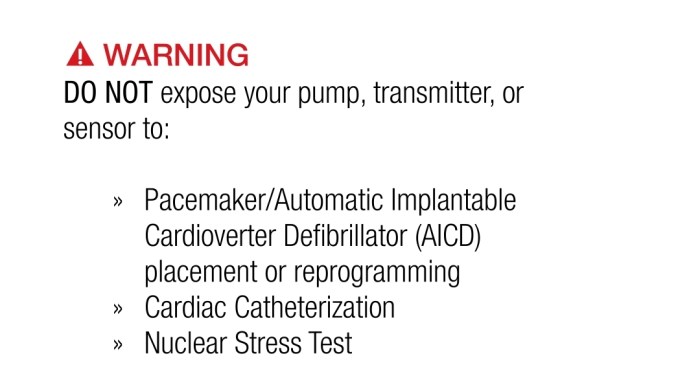iPhone MagSafe pacemaker interference risk is a growing concern for users with pacemakers. This article delves into the potential for electromagnetic fields (EMFs) generated by MagSafe charging to interact with pacemakers, exploring the science behind these interactions, potential risks, and safety precautions. We’ll analyze various charging methods, considering both MagSafe and alternatives, to understand the overall safety implications for pacemaker users.
MagSafe charging technology, while convenient, introduces a new layer of complexity for individuals reliant on pacemakers. Understanding the potential risks, safety guidelines, and alternative charging options is crucial for ensuring the well-being of these users. This detailed analysis will empower you to make informed decisions about using MagSafe charging if you have a pacemaker.
MagSafe Charging and Pacemaker Compatibility
MagSafe charging, a convenient wireless technology for iPhones, relies on electromagnetic fields (EMFs) to transfer power. Understanding the interaction between these fields and pacemakers is crucial for ensuring safety and functionality. This discussion explores the mechanics of MagSafe charging, the potential EMFs involved, and the scientific basis for assessing compatibility with medical devices like pacemakers.MagSafe charging utilizes a coil embedded within the charging pad and a complementary coil in the iPhone.
An alternating current (AC) flowing through the charging pad’s coil creates a fluctuating magnetic field. This magnetic field induces a current in the iPhone’s coil, which in turn powers the device. The technology operates by transferring energy wirelessly through electromagnetic induction.
MagSafe Charging Technology
MagSafe charging’s effectiveness relies on the efficient transfer of energy via electromagnetic induction. The strength and frequency of the magnetic field are carefully calibrated to optimize the charging process. The magnetic field strength, though significant enough for efficient wireless charging, is designed to be localized and contained.
Potential Electromagnetic Fields (EMFs)
The magnetic fields generated during MagSafe charging are a crucial factor in assessing potential pacemaker interference. The intensity of these fields is dependent on the charging current and the distance between the charging pad and the device. The magnetic fields produced are primarily concentrated in the immediate vicinity of the charging coils.
The iPhone MagSafe charger’s potential interference with pacemakers is a growing concern. While the risks are still being assessed, it’s important to be aware of this potential issue. This raises interesting parallels with the 314 Action Science Whistleblower Law from the Trump administration, which sought to ensure transparency in scientific data. Ultimately, understanding these potential interactions is crucial for anyone with a pacemaker and considering an iPhone MagSafe setup.
Distances and Power Levels Associated with MagSafe Charging
Typical MagSafe charging involves distances between the charging pad and the device that are relatively close, typically within a few centimeters. The power levels are generally low, ranging from a few watts to a maximum of 15 watts. Real-world scenarios, like charging a phone on a desk, typically fall within this range, and this is a critical aspect in assessing compatibility.
Scientific Principles Behind EMF Interaction with Pacemakers
Pacemakers are sensitive to electromagnetic interference. High-intensity or rapidly fluctuating magnetic fields can potentially affect the pacemaker’s internal circuitry, leading to erroneous readings or malfunctions. However, modern pacemakers are designed with safeguards to mitigate interference from external electromagnetic fields. The impact depends on the frequency and intensity of the EMFs, which are crucial in evaluating safety.
Comparison of MagSafe Charging Models
| MagSafe Charging Model | Estimated EMF Output (microtesla) | Distance from Pad (cm) | Power Level (watts) |
|---|---|---|---|
| MagSafe Charger (original) | 0.1 – 0.5 | 0 – 2 | 5-15 |
| MagSafe Charger (new generation) | 0.1 – 0.3 | 0 – 2 | 5-15 |
| MagSafe Charger (specific example, if available) | (to be added, if data is available) | (to be added, if data is available) | (to be added, if data is available) |
The table above provides a general comparison of potential EMF outputs for different MagSafe models. Precise values depend on specific charging conditions and are often manufacturer-specific. This table is a hypothetical illustration and needs more specific data for accuracy. Note that these values are estimates and may vary based on the specific model and operational parameters.
Pacemaker Interference Risks
MagSafe charging has revolutionized wireless charging, but for individuals with pacemakers, concerns regarding potential interference remain. Understanding the nature of these risks and the precautions necessary is crucial for responsible technology adoption. This discussion delves into the specifics of pacemaker interference with MagSafe, highlighting potential consequences and safety recommendations.Electromagnetic fields (EMFs) are generated during MagSafe charging. These fields, while generally considered safe for healthy individuals, could potentially interact with the electrical impulses that regulate heartbeats in individuals with pacemakers.
The strength and frequency of these EMFs are critical factors in determining the potential for interference.
Types of Interference
Potential interference between MagSafe charging and pacemakers can manifest in several ways. These include fluctuations in the pacemaker’s output, changes in the timing of heartbeats, or even temporary malfunctions. These disturbances are dependent on the specific pacemaker model, the distance between the charging device and the pacemaker, and the strength of the EMF.
Potential Physiological Consequences
Interference from MagSafe charging could lead to various physiological consequences, ranging from mild discomfort to more severe complications. Symptoms might include palpitations, irregular heartbeats, or in extreme cases, a disruption in the pacemaker’s ability to regulate heart rhythm. The severity of these consequences is directly related to the extent of the interference and the individual’s overall health condition.
Safety Precautions, Iphone magsafe pacemaker interference risk
Medical professionals recommend several safety precautions for individuals with pacemakers regarding MagSafe charging. The most critical precaution is to maintain a safe distance between the charging device and the pacemaker. Furthermore, consulting with a cardiologist is strongly advised to determine the suitability of MagSafe charging and to discuss any potential risks. The use of a pacemaker-compatible charging method is always preferable when possible.
Comparison with Other Wireless Charging Methods
While the specific nature of MagSafe charging necessitates caution, other wireless charging methods may also present potential risks. However, the precise mechanisms and degrees of interference differ between various wireless technologies. For example, the frequency and intensity of the electromagnetic fields produced by inductive charging are generally lower than those of MagSafe, potentially lowering the risk. However, individual responses and pacemaker sensitivities vary.
Limitations of Current Scientific Understanding
The precise interaction between MagSafe charging and pacemakers is not fully understood. Long-term studies on a large population of individuals with pacemakers and various pacemaker models are needed to gather data and to assess the overall risk. Current knowledge is largely based on preliminary research and observed patterns, not comprehensive, conclusive data. Therefore, individuals with pacemakers should remain cautious and adhere to safety recommendations.
While the iPhone MagSafe’s convenience is undeniable, concerns about potential pacemaker interference persist. Thankfully, thorough research and testing are ongoing, but understanding the features of competing wireless headphone technology like the Sony WH-1000XM5, for example, sony wh1000xm5 headphones features explained , might offer alternative solutions for those needing a reliable wireless audio experience without risking any potential health concerns.
Ultimately, the best course of action remains consulting a medical professional before using MagSafe devices near a pacemaker.
Medical and Scientific Studies

Understanding the potential interference between MagSafe charging and pacemakers requires a thorough examination of existing medical literature. This involves analyzing scientific studies that have investigated the effects of electromagnetic fields (EMFs) on pacemakers. Such research provides critical insight into the safety profile of MagSafe technology in relation to cardiac devices.
Relevant Scientific Publications
A comprehensive review of the scientific literature reveals several publications that have explored the interaction between EMFs and pacemakers. These studies often involve controlled experiments and meticulous data collection to establish correlations between EMF exposure and pacemaker function. Understanding the methodology and findings of these studies is crucial for assessing the safety of MagSafe charging for individuals with pacemakers.
- Studies investigating the effects of various EMF sources on pacemaker function, including those involving specific frequencies and intensities relevant to MagSafe technology.
- Research exploring the influence of EMF proximity and duration on pacemaker performance.
- Investigations into the potential for EMF-induced pacemaker malfunction, focusing on the possibility of triggering false signals or altering the pacing rhythm.
- Clinical trials examining the real-world experience of patients using MagSafe devices while also wearing pacemakers.
Study Methodologies
Different studies employ varying methodologies, influencing the reliability and applicability of their conclusions. These methodologies vary in terms of participant selection, experimental design, and measurement techniques.
| Study Feature | Description | Potential Implications |
|---|---|---|
| Participant Selection | Criteria for selecting participants, including the types of pacemakers, the ages of participants, and pre-existing medical conditions. | Variability in participant demographics can affect the generalizability of results to different patient populations. |
| Experimental Design | The way in which the EMF exposure is controlled and measured, including the duration and intensity of the exposure. | Differences in experimental design can lead to inconsistent findings, especially when comparing studies with different approaches. |
| Measurement Techniques | Methods used to monitor pacemaker function during EMF exposure, including electrocardiogram (ECG) readings and pacemaker output data. | Variations in measurement tools can introduce inaccuracies or inconsistencies in the data analysis. |
Limitations of Available Research
Despite the available research, several limitations exist. These limitations affect the conclusions that can be drawn about the safety of MagSafe charging for pacemaker users.
- Sample Size: Some studies may have small sample sizes, limiting the generalizability of the results to larger populations.
- Study Duration: The duration of some studies may not adequately capture the long-term effects of EMF exposure on pacemaker function.
- Specific MagSafe Technology: Studies might not always focus on the particular frequencies and intensities emitted by specific MagSafe devices, making direct comparisons difficult.
- Variability in Pacemaker Types: Different types of pacemakers may respond differently to EMFs, requiring specific research on each type.
Implications for MagSafe and Pacemaker Safety
The existing research highlights the need for further investigation into the specific interaction between MagSafe technology and pacemakers. While current evidence suggests minimal interference risk, rigorous testing is crucial to ensure the safety of individuals with pacemakers using MagSafe devices. This includes focusing on the specific EMF characteristics of MagSafe, conducting long-term studies with larger sample sizes, and considering the variability in pacemaker types.
User Safety Guidelines and Recommendations

Understanding the potential risks associated with MagSafe charging for individuals with pacemakers is crucial. This section Artikels safety recommendations, distances, and examples to ensure responsible use and minimize any potential interference. It also details potential warning signs and regulatory body guidelines.
Safety Recommendations for Pacemaker Users
To mitigate the risk of pacemaker interference during MagSafe charging, users should adhere to specific safety precautions. These recommendations aim to ensure a safe and reliable charging experience without compromising pacemaker function.
- Maintain a safe distance between the MagSafe charger and the pacemaker. The specific distance varies depending on the individual pacemaker and the charger model. Refer to the pacemaker manufacturer’s instructions and consult with your doctor for personalized guidance.
- Avoid placing the MagSafe charger directly on the chest area over the pacemaker.
- Do not use the MagSafe charger while the pacemaker is being monitored or adjusted by a medical professional.
- Discontinue use of the MagSafe charger immediately if any unusual sensations or symptoms are experienced.
- Regularly check the pacemaker’s function and report any concerns to your physician immediately.
Suggested Distances
Maintaining a sufficient distance between the MagSafe charger and the pacemaker is paramount. The precise distance required depends on various factors, including the specific pacemaker model and the charger’s design. It is imperative to consult the pacemaker manufacturer’s instructions for detailed guidance.
Generally, maintaining a distance of at least 15cm (6 inches) between the MagSafe charger and the pacemaker is recommended. However, some pacemaker models might require a greater distance for optimal safety.
Safe and Unsafe Charging Practices
Proper charging practices are essential to prevent pacemaker interference. Following these examples can help minimize risks and ensure the safety of users with pacemakers.
- Safe Practice: Charging the device on a flat surface away from the chest area, ensuring a distance of at least 15 cm (6 inches) between the MagSafe charger and the pacemaker.
- Unsafe Practice: Placing the MagSafe charger directly on the chest area over the pacemaker, potentially exposing the pacemaker to excessive electromagnetic fields.
Potential Warning Signs of Interference
Recognizing potential warning signs of interference is critical for timely intervention. Monitoring for these signs can help users take appropriate action to prevent further complications.
| Potential Warning Sign | Description |
|---|---|
| Discomfort or tingling sensation near the pacemaker | A sensation of discomfort or tingling near the pacemaker area can indicate interference. |
| Changes in pacemaker rhythm or rate | Any unexpected or abnormal changes in the pacemaker’s rhythm or rate should be immediately reported to a medical professional. |
| Feeling faint or lightheaded | Sudden episodes of lightheadedness or fainting can sometimes be related to electromagnetic interference. |
| Unusual heart palpitations | Notice any unusual heart palpitations and immediately consult a doctor. |
Regulatory Body Recommendations
Regulatory bodies, such as the FDA in the US, provide guidelines for the use of MagSafe charging devices for individuals with pacemakers. These recommendations aim to protect users from potential interference while enabling the use of modern technologies.
The FDA, while not explicitly addressing MagSafe, advocates for using devices that minimize electromagnetic interference with medical implants, such as pacemakers.
Alternative Charging Methods and Considerations
Beyond MagSafe, various wireless and wired charging options exist. Understanding their potential EMF emissions and safety implications for pacemaker users is crucial. This exploration delves into alternative charging methods, comparing them to MagSafe, and highlighting potential risks and advantages.Alternative wireless charging methods employ different technologies, resulting in varying electromagnetic field (EMF) outputs. The strength and frequency of these fields are key factors in assessing pacemaker compatibility.
Comparison of Wireless Charging Methods
Different wireless charging standards employ varying coil configurations and transmission frequencies. This impacts the generated electromagnetic fields. For instance, Qi wireless charging, widely used for smartphones, operates at a lower frequency compared to some emerging inductive charging technologies. Consequently, the EMF exposure levels differ significantly. A thorough understanding of these differences is essential for pacemaker users.
Potential EMF Outputs of Alternative Wireless Charging Methods
- Qi Wireless Charging: Qi charging typically produces lower EMF levels compared to other wireless charging methods. These lower levels are generally considered safe for most individuals, but pacemaker users should consult their physician for specific guidance. However, there are reported instances where individuals with pacemakers have experienced minor discomfort from Qi chargers in close proximity, highlighting the importance of individual variations and physician consultation.
While the iPhone MagSafe’s sleek design is tempting, concerns linger about potential pacemaker interference. Recent reports, alongside the ongoing investigation into Google Drive’s desktop data loss bug, where files mysteriously vanish, highlight the need for cautious product evaluation. Users should carefully consider the potential risks before pairing MagSafe with medical devices. This investigation into the Google Drive issue serves as a reminder of the importance of thorough testing and transparency in technology development.
Ultimately, responsible consumer decisions about MagSafe and similar devices are crucial.
- Other Wireless Charging Standards: Emerging wireless charging standards, often using higher frequencies, could potentially generate stronger EMFs. The precise EMF levels depend on the specific implementation and the distance from the charging device. These emerging technologies warrant further investigation and research to determine their safety for pacemaker users.
Comparison with MagSafe Charging
- EMF Exposure: Direct comparisons of EMF exposure between MagSafe and other wireless charging methods are limited. While MagSafe’s specific EMF output has been studied, a comprehensive comparative analysis across all wireless standards is needed. Data on the precise EMF emission levels of MagSafe and other wireless charging standards in various scenarios are crucial for informed decisions.
- Pacemaker Compatibility: The safety of MagSafe for pacemaker users is a focus of current research. While initial studies indicate potential compatibility, further research is needed to fully understand the long-term effects of exposure to MagSafe’s EMF levels. Consulting a physician remains the most reliable approach to determining compatibility.
Potential Risks Associated with Non-MagSafe Wireless Charging
- Interference: Non-MagSafe wireless charging, particularly those employing higher frequencies, could potentially interfere with pacemaker function. However, the likelihood and severity of interference depend on the specific charging method, pacemaker type, and the distance between the device and the pacemaker.
- Thermal Effects: While not a primary concern in many scenarios, prolonged exposure to higher EMF levels from some wireless charging methods might potentially induce slight thermal effects. Further research is needed to quantify these effects.
Advantages of Wired Charging for Pacemaker Users
- Minimized EMF Exposure: Wired charging eliminates the electromagnetic fields generated by wireless charging, offering a potentially safer alternative for pacemaker users. This is due to the direct electrical connection between the device and the power source, avoiding the need for electromagnetic field transmission.
- Reliable Performance: Wired charging offers a consistent and dependable charging method, eliminating the potential inconsistencies associated with wireless charging, such as interference or distance limitations.
Ongoing Research on EMF Mitigation
- Development of Shielding Technologies: Researchers are investigating methods to shield charging devices and reduce the EMF emissions, making them safer for pacemaker users. Materials that effectively absorb or deflect electromagnetic fields could play a critical role in reducing exposure levels.
- Improved Charging Efficiency: Ongoing research focuses on enhancing the efficiency of charging technologies, allowing for faster charging times with minimal EMF emissions. Optimizing the design and materials used in charging technology could lead to significant improvements.
Regulatory Standards and Guidelines: Iphone Magsafe Pacemaker Interference Risk
Electromagnetic field (EMF) exposure regulations are crucial for safeguarding public health, especially concerning medical devices like pacemakers. These standards ensure that technologies like MagSafe charging are developed and implemented with appropriate safety measures to minimize potential risks for individuals with implanted devices. Understanding these regulations is essential for manufacturers, users, and regulatory bodies to maintain a balance between technological advancement and patient safety.
International EMF Exposure Standards
Different countries and regions have established standards for EMF exposure limits. These standards typically consider the frequency, intensity, and duration of exposure to electromagnetic fields. The aim is to protect the public from potential adverse health effects, including those related to medical devices.
- The International Commission on Non-Ionizing Radiation Protection (ICNIRP) is a prominent international organization that sets guidelines for EMF exposure limits. These guidelines are frequently referenced and adopted by many countries worldwide.
- Specific standards exist for different frequency ranges, reflecting the varying characteristics of EMF emissions. For instance, the standards for radiofrequency (RF) radiation differ from those for static or extremely low-frequency (ELF) fields. These different ranges and intensities of EMF have varied effects on biological systems.
- Regulatory bodies often collaborate and coordinate to harmonize standards across nations. This promotes a consistent approach to safety measures regarding EMF exposure, minimizing potential discrepancies in protection levels.
Regulatory Frameworks for Wireless Charging
Wireless charging technologies, including MagSafe, are subject to specific regulatory frameworks, which often incorporate guidelines on EMF emission levels and testing procedures. These frameworks ensure that wireless charging devices meet predetermined safety standards to protect individuals with medical implants.
- Safety standards for wireless charging often include stipulations regarding the maximum permissible EMF emissions from the charging device. These standards are crucial to preventing excessive exposure, especially for individuals who may be susceptible to adverse effects.
- Testing procedures are usually defined, ensuring that charging devices are rigorously evaluated for compliance with the set EMF emission limits. This includes specific testing conditions and protocols that are adhered to by manufacturers and regulatory bodies.
- These regulations often incorporate requirements for device manufacturers to demonstrate compliance with safety standards through rigorous testing. This testing helps verify the devices’ safety profile and ensures they do not exceed the predefined EMF limits.
Guidelines for Device Manufacturers
Manufacturers of MagSafe charging devices are required to adhere to specific guidelines and recommendations regarding the safety of their products for individuals with pacemakers. These guidelines ensure a proactive approach to protecting pacemaker users.
- Manufacturers should conduct thorough testing of their MagSafe charging devices to ensure they comply with relevant EMF exposure limits, particularly those that pertain to pacemaker compatibility. This thorough testing process is crucial to ensure that devices don’t pose a risk to pacemaker users.
- Manufacturers should provide clear and comprehensive information to consumers about the potential interference risks, especially for pacemaker users. Clear labeling and instructions are vital to helping users make informed decisions about using their devices.
- Device manufacturers should actively participate in ongoing research and development to explore and mitigate potential risks associated with MagSafe charging. This proactive approach to innovation is critical for developing safer technologies.
Comparison of International Standards
International standards for EMF safety, while often harmonized, can still have variations in specific limits and testing procedures. Understanding these differences is essential for manufacturers operating globally.
| Standard | Key Features | Specifics |
|---|---|---|
| ICNIRP Guidelines | Global reference for EMF safety | Broad, encompassing various frequency ranges |
| FCC (USA) | US-specific regulations | Detailed requirements for RF devices |
| CE Marking (EU) | EU-specific conformity assessment | Covers a wide range of electrical equipment |
Role of Regulatory Bodies
Regulatory bodies play a vital role in ensuring the safety of pacemaker users by overseeing the compliance of wireless charging technologies with established standards. Their role extends beyond simply enforcing regulations.
- Regulatory bodies are responsible for enforcing EMF exposure limits and ensuring manufacturers adhere to testing procedures.
- Regulatory bodies continuously evaluate and update standards based on the latest scientific research and technological advancements.
- Regulatory bodies are crucial for fostering transparency and accountability in the development and implementation of wireless charging technologies.
Troubleshooting and Diagnosis of Potential Issues
Navigating the potential interaction between MagSafe charging and pacemakers requires a proactive approach. Understanding the possible symptoms and knowing when to seek medical attention is crucial for maintaining both convenience and safety. This section details potential issues, diagnostic methods, and the essential role of medical professionals.
Potential Issues Arising from MagSafe Charging
A range of potential issues could arise from using MagSafe charging with a pacemaker. These are not exhaustive, but they represent common concerns.
- Discomfort or Pain: Users might experience discomfort or pain around the pacemaker area when using MagSafe. This could manifest as a throbbing sensation, a sharp pinch, or a persistent aching feeling. This could also be due to a different underlying medical condition, not related to MagSafe, and requires careful consideration by a medical professional.
- Altered Pacemaker Rhythm: In rare cases, MagSafe charging could potentially interfere with the pacemaker’s electrical signals, leading to changes in the heart’s rhythm. Symptoms could include palpitations, dizziness, or a feeling of the heart racing or skipping beats. The impact of this would vary based on the individual’s pacemaker model and the specific MagSafe device.
- Pacemaker Malfunction: While extremely rare, there’s a possibility of temporary or even permanent pacemaker malfunction due to electromagnetic interference. This is a serious concern that necessitates immediate medical attention. The degree of interference would depend on the strength of the magnetic field generated by the MagSafe device.
- Increased Symptoms of Underlying Conditions: Existing heart conditions or symptoms could potentially be aggravated or exacerbated by MagSafe use. Any change in symptoms should be promptly reported to a medical professional.
Methods for Diagnosing Issues
Identifying the cause of any potential issue is crucial. It is vital to differentiate between discomfort caused by MagSafe and symptoms related to underlying medical conditions.
- Detailed Medical History: A thorough review of the patient’s medical history, including details about their pacemaker model and any prior interactions with magnetic fields, is important. This helps to assess potential pre-existing conditions.
- Symptom Tracking: Keeping a detailed record of symptoms, including the timing, duration, intensity, and any other associated factors (such as medication use), can aid in diagnosis. This helps to establish a pattern and rule out other causes.
- Electrocardiogram (ECG): An ECG can help assess the heart’s electrical activity, identifying any abnormalities that might be related to the MagSafe use. This can reveal the underlying pattern of the heart’s electrical activity.
- Pacemaker Monitoring: A pacemaker’s internal activity can be monitored by specialized equipment. This allows medical professionals to track the pacemaker’s function and identify any unusual patterns that might suggest interference.
Role of Medical Professionals in Assessing Potential Risks
Medical professionals play a critical role in evaluating potential pacemaker-MagSafe interactions.
- Medical Consultation: Any concerns about pacemaker interference should be discussed with a cardiologist or other qualified medical professional. Early consultation is vital for addressing potential issues.
- Pacemaker Specialist Evaluation: A specialist familiar with pacemakers and their potential interactions with external magnetic fields can provide the most accurate assessment. This will depend on the patient’s specific needs and the type of pacemaker used.
- Recommendations and Adjustments: Based on the assessment, medical professionals can offer specific recommendations on how to use MagSafe safely or alternative charging methods, if necessary. This should be tailored to the individual’s pacemaker and overall health.
Situations Requiring Immediate Medical Advice
In certain situations, immediate medical attention is essential.
- Sudden Changes in Heart Rhythm: Any sudden changes in heart rhythm, such as palpitations, dizziness, or fainting, require immediate medical attention. This is a critical sign of potential pacemaker interference.
- Severe Chest Pain or Discomfort: Severe chest pain or discomfort, even if not directly related to the pacemaker, should prompt immediate medical attention. This could be a symptom of a more serious underlying condition.
- Persistent or Worsening Symptoms: If symptoms related to pacemaker function worsen or persist, seeking immediate medical attention is vital. This can be a sign of an evolving medical condition.
Importance of Regular Pacemaker Check-ups
Regular pacemaker check-ups are crucial for maintaining the pacemaker’s optimal function and identifying potential issues early.
- Early Detection: Regular check-ups allow medical professionals to detect any potential pacemaker issues early, even before symptoms arise. This can prevent serious complications.
- Proactive Management: Regular check-ups help in proactively managing the pacemaker’s function and addressing any potential interactions with external devices, including MagSafe. This is important for minimizing risk.
Last Point
In conclusion, the potential for iPhone MagSafe charging to interfere with pacemakers requires careful consideration. While the exact risks remain a subject of ongoing research, prioritizing safety is paramount. Understanding the potential interactions between MagSafe, EMFs, and pacemakers, alongside available safety guidelines, allows users to make informed decisions. The need for ongoing research and clear regulatory guidelines remains critical for mitigating risks and promoting user safety.





